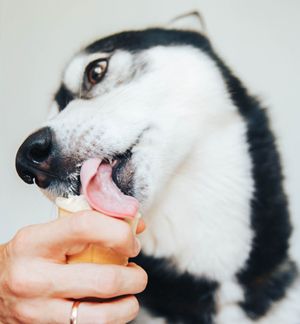The Fear Free exam room: Beyond easy cheese and yoga mats
Try these unusual tips to reduce veterinary patients fear and anxiety during a trip to your hospital.

Spreading soft food in an ice cream cone can keep a patient distracted long enough to do a veterinary exam, says Fear Free expert Mikkel Becker, CPDT. Image: Shutterstock.com.Are you all, “Been there; done that” when it comes to Fear Free veterinary practice? You've read the “get started” guides for lowering patient stress in the clinic and are ready for something you haven't heard before? Fear Free experts Debbie Martin, CPDT-KA, KPA CTP, LVT, VTS (behavior), and Mikkel Becker, CBCC-KA, CDBC, KPA CTP, CPDT-KA, CTC, are here to help. Here are some next-level tips for easing patients' anxiety.
1. Place a litterbox in the exam room. If you're a cat and you're already freaked out by the strange smells and sounds of the veterinary hospital, a full bladder or colon doesn't help, Martin notes. A litterbox in the corner keeps fastidious felines from having to choose between eliminating on the floor and holding it.
2. Stash a box of ice cream cones. The cone is one of Becker's favorite ways to dispense spreadable or soft foods to dogs and cats during care.
“We often will fill these with a treat and have the animal lick it out as we do needed handling or other care,” she says.
3. Find creative ways to slow down food consumption. Becker also places spreadable treats in washable food puzzles or freezes broth in soft-sided, washable ice cube trays. While the pet is licking the yumminess out of every nook and cranny, the team has more time to do the exam, administer vaccines and so on.
“I've gotten some varieties at places like Ikea that come in fun shapes like hearts,” Becker says. “This puts the ‘treat into treatment' for the humans too.”
4. Don a pair of HandsOn Gloves. Becker finds that many animals-dogs, cats and horses-love these de-shedding and grooming gloves and will happily remain in place as long as they're getting their “massage.” This settles and soothes the pet while adding a pleasurable form of gentle control, Becker says, keeping the animal calmly in place as the team examines it or performs care.
Veterinary scene down under: IV fluid shortage updates, and more news
September 3rd 2024Updates on the intravenous fluid shortage impacting Australian veterinary practices, a welcome funding boost for the Veterinary and Community Care charity, and Australia’s first Fear Free Certified veterinary practice.
Read More